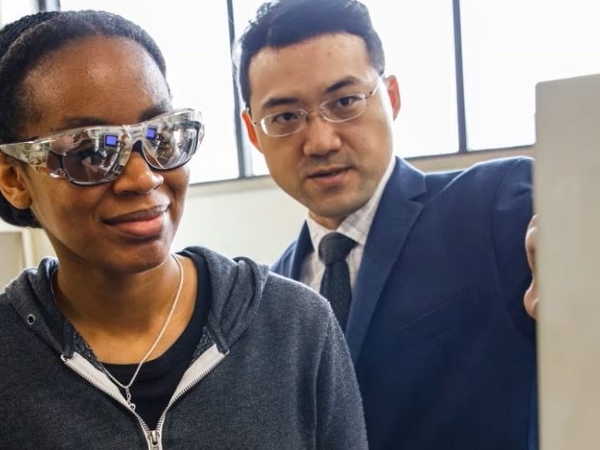Chun-Wei Yao LU’s Center for Midstream Management and Science first profile honoree
July 10, 2020 | by Shelly Vitanza
Lamar University's Center for Midstream Management and Science has launched Profiles in Midstream and named Chun-Wei Yao its first honoree.
“We've instituted a regular honoree program that will be posted on the Center’s website to honor LU faculty doing good work related to the midstream industry as well as favored industry people, too,” said Thomas Kalb, director of the Midstream Center Management and Science. “Our first Honoree - Dr. Chun-Wei Yao – is being recognized for his recent work in materials science.”
doing good work related to the midstream industry as well as favored industry people, too,” said Thomas Kalb, director of the Midstream Center Management and Science. “Our first Honoree - Dr. Chun-Wei Yao – is being recognized for his recent work in materials science.”
Yao, an assistant professor in the Department of Mechanical Engineering and director of Advanced and Surface Engineering Lab at LU, is conducting work on corrosion preventing top coatings, an area of great importance to the midstream industry.
“We applaud his thoughtful work and thank him for support of the midstream industry, and the Midstream Center's mandate to promote the collaboration and dialogue between industry and Lamar University,” said Kalb.
Corrosion is a significant problem of pipeline infrastructures and generates enormous costs to the oil and gas industry. Recently, novel superhydrophobic top coatings have been favored due to their inherently water-repellent nature. However, durability and corrosion resistance of superhydrophobic top coatings are still questions in implementation.
“The main objectives of my project are to fabricate superhydrophobic top coatings for enhanced corrosion resistance and durability properties,” said Yao. “We are evaluating the mechanical performance of developed coatings and localized corrosion rates to discern their implementation in the industry.”
Yao’s primary area of expertise is surface science and engineering. His research team has designed and fabricated a variety of nano/microstructured surfaces. For example, the team created superhydrophobic nanograss-like structures with enhanced corrosion resistance for various engineering applications such as condensers, heat pipes or copper cooling channels. The team has also developed a facile superhydrophobic coating that has high polarization resistance and a low corrosion rate. Furthermore, the team is investigating micro/nanoscale interactions between coatings and corrosive environments using in-situ atomic force technique. Additionally, Yao has also focused on the dynamics of microdroplets.
“Superhydrophobic coatings have attracted a lot of attention because of the relevance in various applications,” said Yao, who sits on the Midstream Center’s Faculty Advisory Board. “We anticipate improving the coatings’ mechanical durability in the very near future.”
“We've instituted a regular honoree program that will be posted on the Center’s website to honor LU faculty
 doing good work related to the midstream industry as well as favored industry people, too,” said Thomas Kalb, director of the Midstream Center Management and Science. “Our first Honoree - Dr. Chun-Wei Yao – is being recognized for his recent work in materials science.”
doing good work related to the midstream industry as well as favored industry people, too,” said Thomas Kalb, director of the Midstream Center Management and Science. “Our first Honoree - Dr. Chun-Wei Yao – is being recognized for his recent work in materials science.” Yao, an assistant professor in the Department of Mechanical Engineering and director of Advanced and Surface Engineering Lab at LU, is conducting work on corrosion preventing top coatings, an area of great importance to the midstream industry.
“We applaud his thoughtful work and thank him for support of the midstream industry, and the Midstream Center's mandate to promote the collaboration and dialogue between industry and Lamar University,” said Kalb.
Corrosion is a significant problem of pipeline infrastructures and generates enormous costs to the oil and gas industry. Recently, novel superhydrophobic top coatings have been favored due to their inherently water-repellent nature. However, durability and corrosion resistance of superhydrophobic top coatings are still questions in implementation.
“The main objectives of my project are to fabricate superhydrophobic top coatings for enhanced corrosion resistance and durability properties,” said Yao. “We are evaluating the mechanical performance of developed coatings and localized corrosion rates to discern their implementation in the industry.”
Yao’s primary area of expertise is surface science and engineering. His research team has designed and fabricated a variety of nano/microstructured surfaces. For example, the team created superhydrophobic nanograss-like structures with enhanced corrosion resistance for various engineering applications such as condensers, heat pipes or copper cooling channels. The team has also developed a facile superhydrophobic coating that has high polarization resistance and a low corrosion rate. Furthermore, the team is investigating micro/nanoscale interactions between coatings and corrosive environments using in-situ atomic force technique. Additionally, Yao has also focused on the dynamics of microdroplets.
“Superhydrophobic coatings have attracted a lot of attention because of the relevance in various applications,” said Yao, who sits on the Midstream Center’s Faculty Advisory Board. “We anticipate improving the coatings’ mechanical durability in the very near future.”